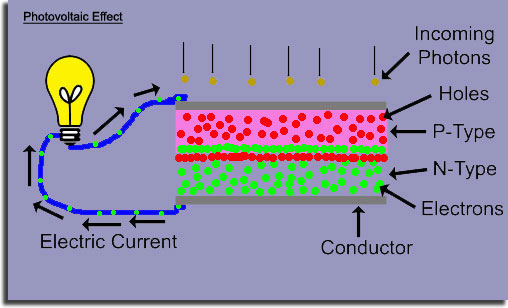 |
What is Solar?
"Solar power" is defined as the conversion of solar energy (light) to a form of useable energy such as electricity or heat. In most cases, the useable form of energy desired is electricity. There are a couple different methods used to generate electricity from light. Photovoltaics, which is the type of solar power system that you would normally see a solar contractor installing on the roof of a home or business, converts sunlight into direct current electricity through the photovoltaic effect (see below). Two other methods utilized are concentrated solar energy and solar hot water systems.
Photovoltaics
Although it was discovered by scientists in the mid to late 1800's, the photovoltaic (PV) effect was not fully understood until Albert Einstein's theoretical explanation of it in 1904, which he was subsequently awarded the Nobel Peace Prize for in 1921. "Photo-voltaics" can literally be translated to "light-electricity." 
Discrete packets of light energy known as photons, strike the PV cell, knocking the electrons in the silicon material out of their normal energy state, putting them in a position to be conducted as electricity. This phenomenon is exploited to form the individual solar cells on wafers of silicon. The output of each photovoltaic cell is dependent on the exact size, material, and method of manufacturing. Since Silicon is naturally reflective in nature, each photovoltaic cell is typically covered with an anti-reflective coating to minimize any loss from reflection.
The photoelectric effect only occurs when a photon which has the correct amount of energy strikes an atom in the solar cell. The amount of energy needed is dependent on the material the solar cell is made from. This means that the solar cell is not able to convert all the different wavelengths of light which are hitting it. Because of this, solar cells are "tuned" during their creation to to absorb the spectrum of sunlight that is most intense.
Photovoltaic Modules
What you see on the roof of a home or commercial structure which has a solar power system are photovoltaic "modules," not "cells." A photovoltaic module is actually an array of "solar cells" which are interconnected and packaged into a form which is easily utilized in an everyday system. The individual solar cells are typically connected in a series configuration and protected by the module package.
Each module has ratings that are associated with it's nominal performance. Here is a sample solar module data sheet that contains three different module versions, a 170W, a 175W, and a 180W:
Characteristics |
180 W |
175W |
170W |
|---|---|---|---|
Open-Circuit Voltage (Voc) |
44.8V |
44.7V |
44.4V |
Optimum Operating Voltage (Vmp) |
36.0V |
35.8V |
35.6V |
Short-Circuit Current (Isc) |
5.29A |
5.23A |
5.15A |
Optimum Operating Current (Imp) |
5.0A |
4.9A |
4.8A |
Maximum Power at STC (Pmax) |
180Wp |
175Wp |
170Wp |
Operating Temperature |
-40C to +85C |
-40C to +85C |
-40C to +85C |
Maximum System Voltage |
1000V DC |
1000V DC |
1000V DC |
Maximum Series Fuse Rating |
15A |
15A |
15A |
Power Tolerance |
+- 3% |
+-3% |
+-3% |
Each of these different parameters are explained in detail on our solar panels page.